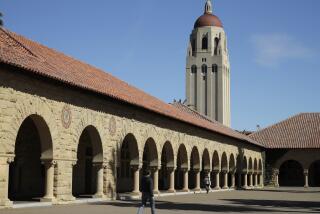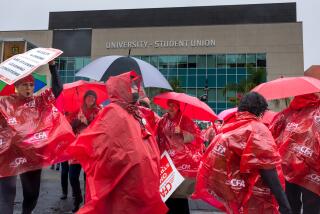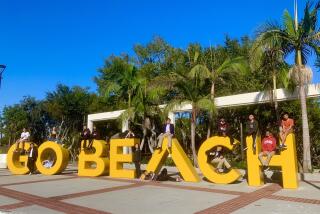Cal State leader lays out plan to speed graduation

California State University Chancellor Timothy P. White on Wednesday announced an ambitious agenda to move students more quickly to graduation by hiring more experienced faculty and advisors, increasing online courses and boosting other opportunities to help students succeed.
The measures are part of a $50-million project that aims over the next decade to increase graduation rates by 10% for undergraduates and 5% for those who transfer from community colleges as well as to improve the overall learning environment for students, White said.
The plan was announced in White’s first “state of the university” address to the Board of Trustees in Long Beach. The 23-campus system is the largest system of higher education in the nation, serving more than 440,000 students.
“Our top priority must be to firm up our fiscal and policy commitments to access, persistence to degree and degree completion — to improve the educational experience and degree attainment for all students and to enable students to earn a high quality degree in a shorter amount of time, “ White said.
Gov. Jerry Brown, who attended the meeting, said he was impressed by White’s plan.
“Good, solid,” Brown said. “It lays out the challenges, but also recognizes the fantastic contributions the state colleges make to California.”
White, who took over as chancellor in December 2012, said in an interview after his address that funding for the proposals would come from state funds, as well as philanthropic and corporate interests. Brown’s 2014-15 spending plan includes an increase of $142.2 million for Cal State, less than the $237.6 million the university had hoped for.
White said that some money for the new initiative might need to be redirected from other programs, but that he would consult with faculty and college leaders. Tuition, however, was expected to remain flat, with the possible exception of some campus-based and other fees, he said.
White identified seven key areas to spur student success:
• Hiring more tenure-track faculty as opposed to lecturers, who may be less experienced and may have less time to mentor students.
• Appointing more advisors to help students graduate.
• Developing more online courses in high-demand subjects that would be open to students from all campuses.
• Ensuring that more students are prepared for college-level English and math before enrolling.
• Increasing programs such as internships, study abroad and service learning, that keep students in school.
• Gathering more data about what programs work.
• Using admission preferences to improve access for community college transfers.
These moves are crucial, White said, because the state will need to produce an additional 1 million college graduates by 2025 to meet workforce needs. Cal State, he noted, awards nearly half of the state’s baccalaureate degrees.
Meanwhile, demand is greater than ever. The system received more than 760,000 undergraduate applications for fall 2014.
Board Chairman Bob Linscheid said the initiative reflects the board’s charge to focus more fully on meeting student needs.
“If each part [of White’s plan] can make a small bite into the problem, it goes a long way to getting to a solution,” Linscheid said.
California Faculty Assn. President Lillian Taiz said it was important to hear White characterize the system as a public good.
“He hit the themes that we wanted to hear,” said Taiz, who teaches history at Cal State Los Angeles.
The university faces a number of obstacles, including meeting the needs of a sizeable number of students — 145,000 in 2012-13 — in the lowest income bracket, earning $20,262 or less, as well as large numbers of part-time students who work.
Another challenge is a huge backlog of buildings and facilities needing maintenance totaling more than $2 billion, including $500 million in urgent repairs.
Trustees were given a graphic example from San Francisco State University, where the campus science building was closed because of high levels of mercury, asbestos and lead.
The campus had to relocate classes and laboratory space for more than 9,000 students, said president Leslie E. Wong.
“We don’t know when the building will be usable again and we have no idea if the building is reusable,” Wong said.
But with the state facing $63 billion in deferred maintenance needs of its own, the university may have a tough time convincing Sacramento to increase funding for repairs, the governor said.
In better news, philanthropic support for the system reached a record high in 2012-13, with gift commitments of $338 million, a 14% increase from the previous year and charitable gift receipts of nearly $283 million. The market value of Cal State’s endowment stands at about $1.18 billion.
Also Wednesday, veteran educator Jane Close Conoley was named president of Cal State Long Beach. Conoley, 66, is currently dean of the Gevirtz Graduate School of Education at UC Santa Barbara.
Conoley will be the seventh president at the 65-year-old campus and its first female leader. Trustees will set her salary at a meeting in March.
More to Read
Start your day right
Sign up for Essential California for news, features and recommendations from the L.A. Times and beyond in your inbox six days a week.
You may occasionally receive promotional content from the Los Angeles Times.







